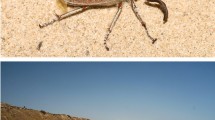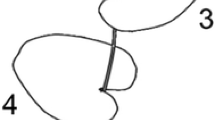Abstract
After the rinderpest panzootic of the late last century, Southern Mozambique appeared to have become free of Glossina morsitans and G. pallidipes. However, since the 1940s a gradual advance of tsetse into Southern Mozambique has been observed. Anti tsetse measures were taken during the 1950s and 1960s along the southern front of the tsetse belt to stop the advance of the fly into tsetse free cattle grazing areas.
To reassess the extent of the fly front in Inhambane Province, a tsetse survey using bait oxen was made in the Muabsa area during 1981 and 1982. G. m. morsitans, G. pallidipes and G. austeni were found, although not always sympatrically. It appeared that the G. morsitans and G. pallidipes front in the study area had been stable since 1969. The front is situated along a line of marked changes in soil and vegetation types and it is concluded that this may be the reason why these tsetse did not advance further south. G. austeni was found throughout the study area in a less well defined belt. The populations of G. m. morsitans and of G. pallidipes in the study area form the most southerly distributed populations of these species known in Africa today.
Résumé
Après l’épidémie de peste bovine à la fin du siècle dernier, le sud du Mozambique parût libéré de son infestation de Glossina morsitans et de G. pallidipes. Cependant, depuis les années 1940, un retour progressif de la glossine a été observé dans le sud du Mozambique. Pendant les années 1950–1970, une campagne de lutte contre la mouche tsé-tsé a été effectuée le long de la limite sud de la zone de glossines, pour prévenir qu’elles réenvahissent des pâturages importants. Pour déterminer la répartition des glossines dans la province de Inhambane, une enquête a été réalisée dans la région de Muabsa au courant de 1981 et 1982. Glossina morsitans, G. pallidipes, et G. austeni ont été capturées, mais pas toujours sympatriquement. La limite extrème de distribution de G. morsitans et G. pallidipes dans la zone étudiée parâit être stable depuis 1969. Cette limite de distribution est située le long d’un changement évident de végetation et de sols, et on conclue que ces changements préviennent le progrès de ces glossines vers le sud. Glossina austeni fut aussi capturé dans la zone d’étude, mais sa distribution est moins définie. Les populations de G. morsitans et G. pallidipes dans cette region sont à présent celles les plus au sud du continent africain.
Similar content being viewed by others
References
Baldry D. A. T. and Evison C. (1981) The distribution of Glossina morsitans in Zambia. In International Scientific Council for Trypanosomiasis Research and Control, Seventeenth Meeting, Arusha, 1981. pp. 391–397.
Du Toit R., Kluge E. and Fiedler D. G. H. (1954) The eradication of G. pallidipes from Zululand by chemical means. In International Scientific Council for Trypanosomiasis Research and Control, 5th Meeting, Pretoria, 1954, p. 141.
Ford J. (1970) The geographical distribution of Glossina. In The African Trypanosomiases (Edited by Mulligan H. W.). George Allen and Unwin Ltd., London.
Ford J. (1971) The Role of the Trypanosomiases in African Ecology. A study of the Tsetse Fly Problem. Clarendon Press, Oxford.
Hornby H. E. (1947) Report on a Survey to Ascertain if There be a Danger that the Glossina morsitans Belt Associated with the Rio Save may Spread South-West to the Rio Limpopo and Beyond. Imprensa Nacional de Moçambique, Lourenço Marques.
Howard C. W. (1911–1912) The distribution of tsetse flies in the province of Moçambique, East Africa. Bull ent. Res. II, 39–42.
MCT (1954) Annual Report, Lourenço Marques.
MCT (1972) Annual Report, Lourenço Marques.
Marques da Silva J. (1952) Reconhicemento glossinico efectuado no vale do Rio Save—Circunscrição do Govuro. Anais do Instituto de Medecina Tropical IX, Lourenço Marques, pp. 893–924.
Rafael A. G. (1973) O avançco da Glossina morsitans a sul do Rio Save e medidas para o seu controle. Anais dos Serviços de Veterinaria de Moçambique 17/19, 427–439.
Takken W. (1984) Studies on the biconical trap as a sampling device for tsetse (Diptera:Glossinidae) in Mozambique. Insect Sci. Applic. 5, 357–361.
Travassos Santos Dias J. A. (1951) Resultados de um reconhecimento glossinico a algumas circunscriçaes da provincia do sul do Save. Anais do Instituto de Medecina Tropical VIII, Lourenço Marques, pp. 313–356.
Travassos Santos Dias J. A. (1971) Proposta para a criação da. Reserva de caça de Zinave. Universidade de Lourenço Marques, Lourenço Marques.
Travassos Santos Dias J. A. and Rosinha A. J. (1971) Proposta para a criação do. Parque Nacional do Bahine. Universidade de Lourenço Marques, Lourenço Marques.
Weitz B. (1963) The feeding habits of Glossina. Bull. World Hlth. Organ. 28, 711–729.
Author information
Authors and Affiliations
Rights and permissions
About this article
Cite this article
Takken, W. Ecological Factors Limiting the Distribution of Glossina morsitans morsitans and of Glossina pallidipes (Diptera: Glossinidae) in Inhambane Province of Mozambique. Int J Trop Insect Sci 9, 237–242 (1988). https://doi.org/10.1017/S1742758400006056
Received:
Revised:
Published:
Issue Date:
DOI: https://doi.org/10.1017/S1742758400006056




